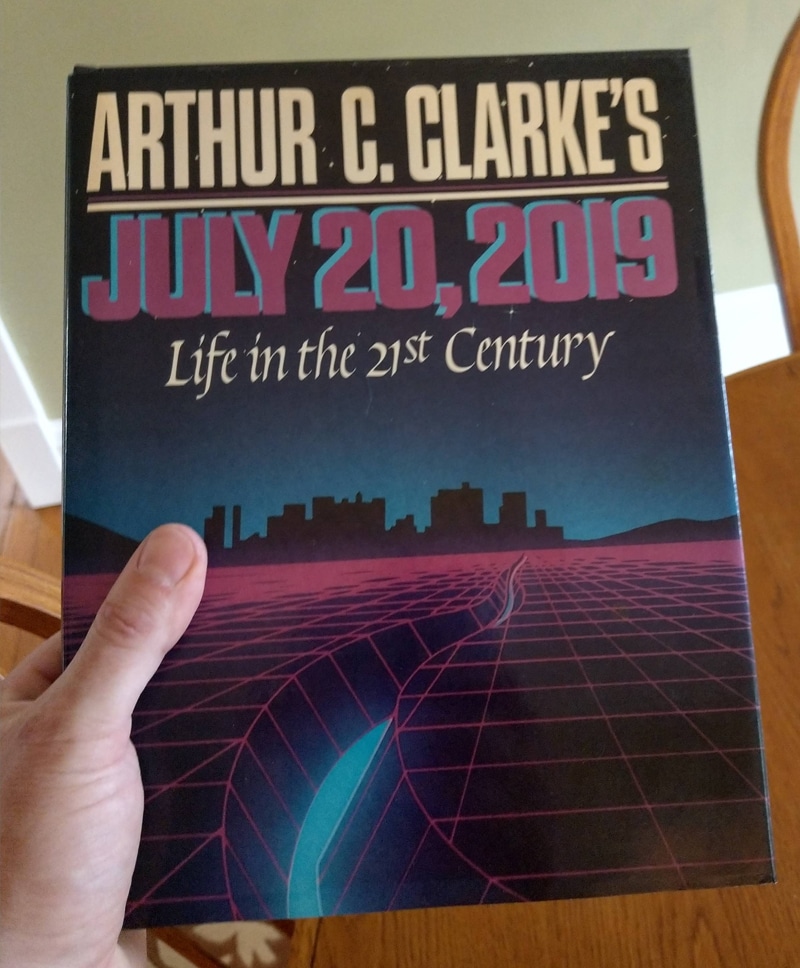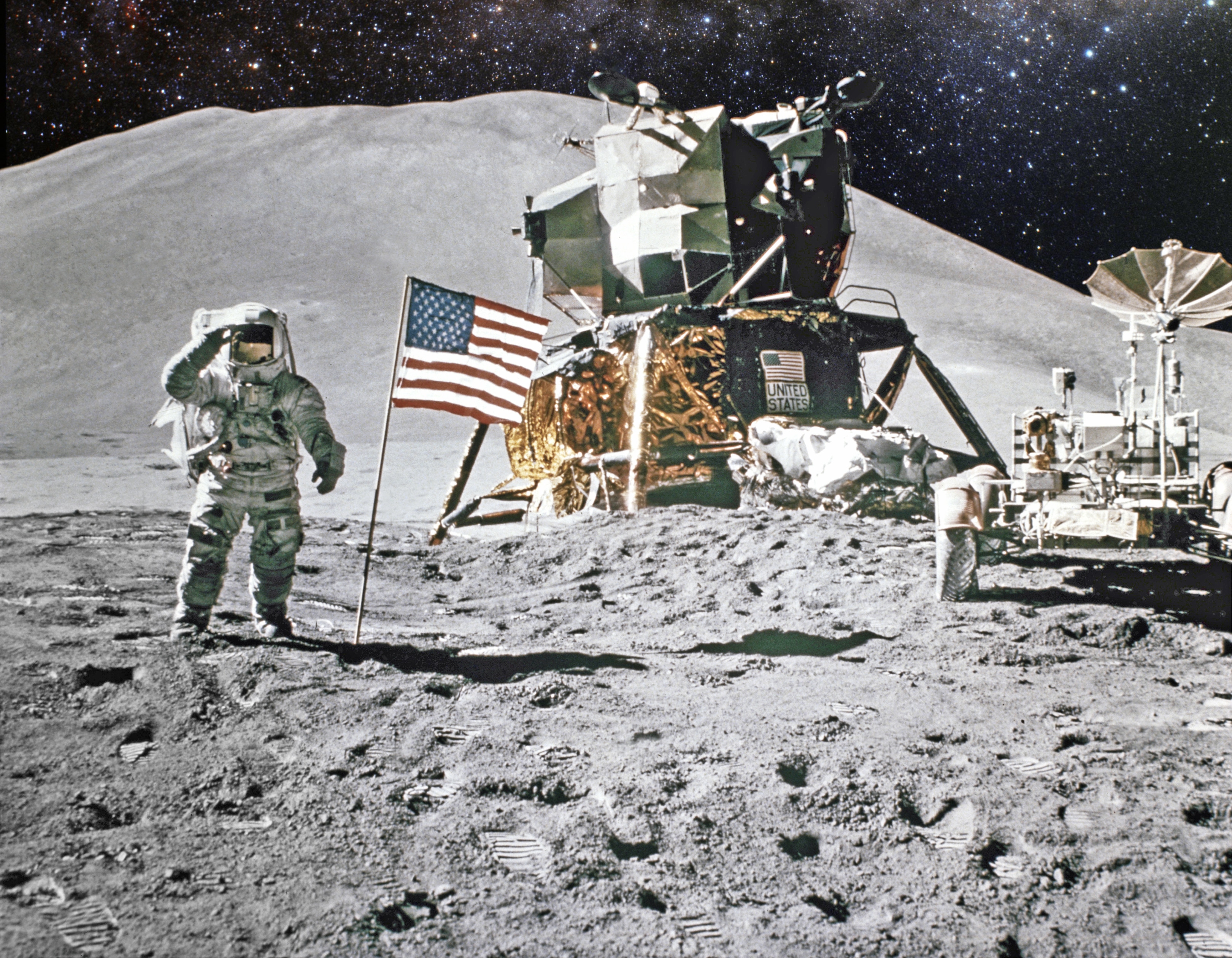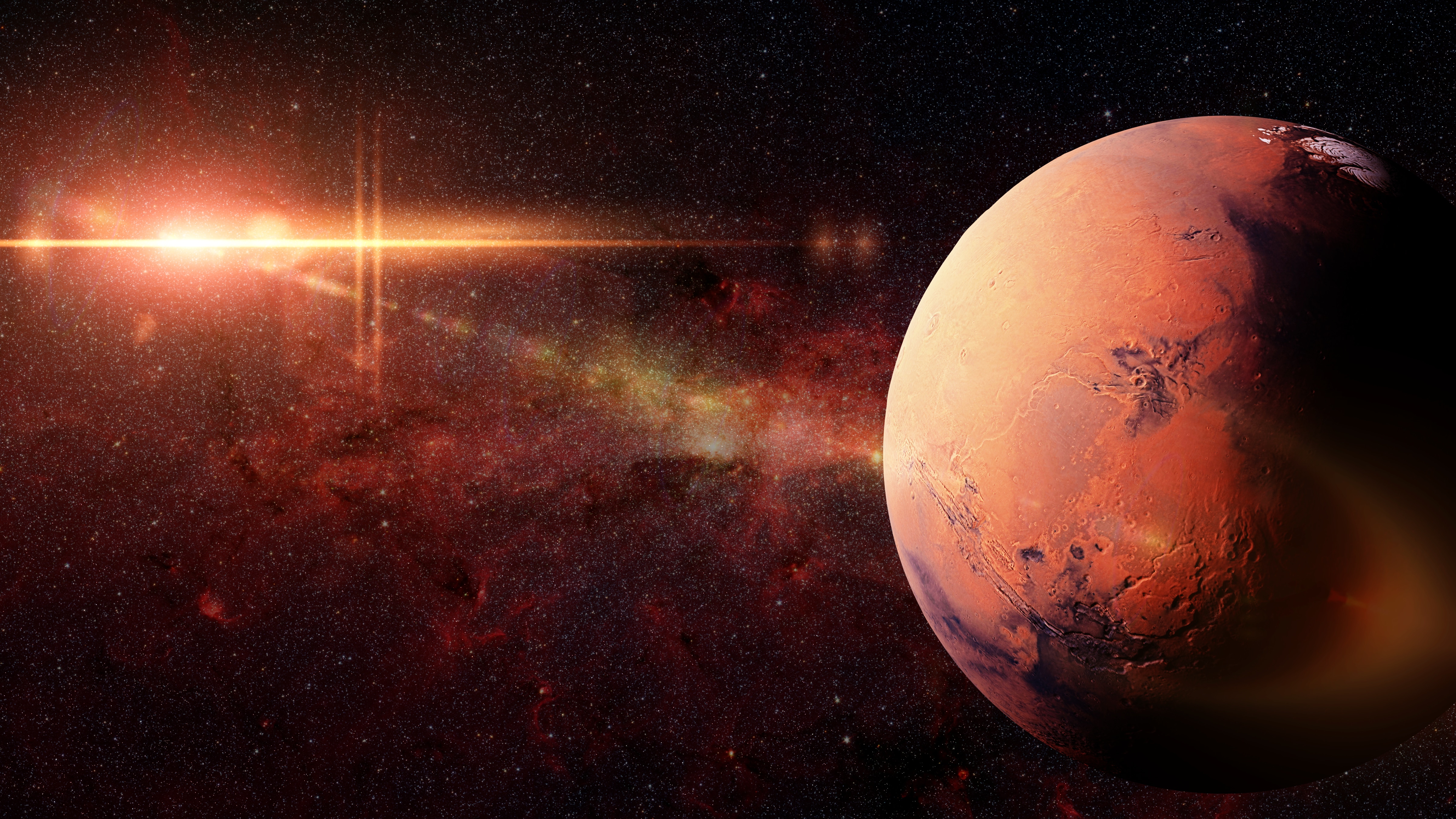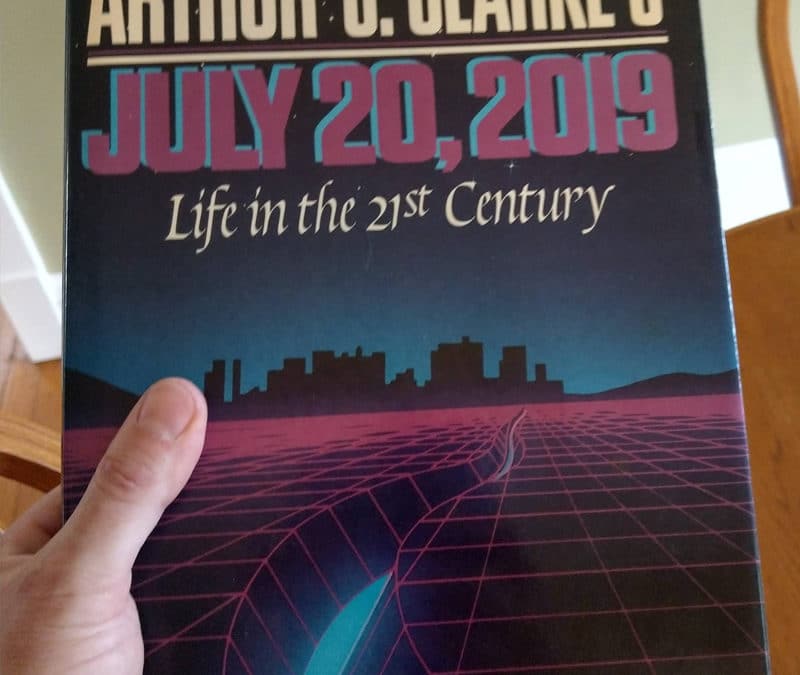Some time in 2014 I picked this up at a yard sale. It was hard to resist, for a $1, with the day of the title coming up. Arthur C. Clarke, renowned science fiction writer, published this strange, heavy book in 1986, imagining this day in 2019 that would commemorate the fiftieth anniversary of the moon landing in 1969. It’s not, Clarke was adamant, an attempt at prophecy, but (as he said of his work generally), “An inquiry into the Limits of the Possible.”
Arthur C. Clarke’s
JULY 20, 2019
Life in the 21st Century
Purchase Here

The book’s a mash-up of genres and temporal spaces and is laid out like an entry in one of those Time Life collections. Clarke addresses the reader as his 1986 self in a preface and in chapters that cover the cutting edge of science and technology back then, by way of imagining where they might take (might have taken) us. Each chapter is punctuated with short sci-fi vignettes painting a picture of what today might have looked like, based on the limits of the possible in 1986. When it comes to thinking about the legacy of the moon landing, in particular, it’s instructive. From the standpoint of actual July 20, 2019, it’s sort of fun but sort of not, which was probably inevitable.
I should start by saying that, for a sci-fi fan, I’m not super familiar with Clarke’s work. I study religion, so I’ve read “The Nine Billion Names of God” and a few other stories. Clarke’s brand of “hard SF” has never been my thing. I didn’t get 2001 and I’m not ashamed to say so. There’s a spirit to this book that I am drawn to, though.
“Clarke’s vision of today has been most closely realized where entertainment is concerned… Still Gone with the Wind, a sequel starring the original cast and sets, digitally “resurrected,” which may as well be the “live action” Lion King—both because it’s digitally rendered and because it demonstrates that Hollywood has no new ideas. “
I picked it up expecting there to be some howlers in Clarke’s vision of our today, and there are some. Travelling at Mach 22 is not yet a thing for “everyday travelers” (or anyone, actually) (73). In one scene of wakeup time on a space station “someone switches on a laserdisc and starts playing country music” (112). Clarke was certain that clandestine use of performance enhancing drugs among athletes would be supplanted by “trained experts carefully dispensing them,” openly (165).
The biggest miss is the absence in Clarke’s 2019 of anything that looks like the internet. Teleconferencing and distance education are there, but the Web really isn’t. Clarke imagines smart homes where your fridge can talk to your toaster, but they operate in a closed system run by a household mainframe, not through cloud-interfacing networks that report your eating habits to multinational corporations. Your kitchen can have dinner ready for you when you get home, but if you’re running late you’ll need to “call home and tell your home computer to delay the meal.” (Ostensibly from your landline at work, as there aren’t really cell phones here, either.)
I really do have a robot vacuum cleaner, though (54) and advances in automobiles have been, as predicted, mostly about improving the gasoline engine (90). Along with the fish-in-a-barrel prediction of Viagra, Clarke’s chapter on sexuality has much that’s happily familiar about the “growing stature of women in society” and increased acceptance of and options for transgendered people. He was much too confident about the protection of reproductive rights, however, and–other than one brief mention of Harvey Milk High School, founded in 1985–homosexuality does not seem to exist in Clarke’s 2019. Clarke was gay himself, and it was 1986, so maybe he had his reasons.
Clarke’s vision of today has been most closely realized where entertainment is concerned. Opening today in movie theatres: Still Gone with the Wind, a sequel starring the original cast and sets, digitally “resurrected,” which may as well be the “live action” Lion King—both because it’s digitally rendered and because it demonstrates that Hollywood has no new ideas.

Television did get awesome, as Clarke predicted, and (though there’s no streaming, exactly, in his version) everyone can watch what they want, when. “Entertainment moguls treat today’s audiences as if they were all the same; in 2019, entertainment will be far more individualized” (148).
He’s also pretty good with respect to advances in the biological and medical sciences–parents selectively engineering their children, labs growing replacement organs, robots doing surgeries. None of these things is necessarily commonplace today, but they are all things that we are aware are in the offing and very much possible (way more possible right now than putting a person on the moon again). Wonderfully, he observes the central role that insurance providers will play in the use of such advances. You might be able to get a robotic arm (or, uh, penis…), but only if you find an in-network provider.
Some of the misses, moreover, are more poignant than funny. Clarke believed in science and progress, and while here, at least, he mostly bridles a tendency toward technological determinism, he ends with a rousing prediction of the “Global Family” of humanity that would be born out of global communications, quoting a speech he actually made to the UN General Assembly in 1983. This prediction comes from the assumption that greater communication among the people of the planet would necessarily mean more understanding. Well.
“I am thoroughly pro-space—which manifests today as pro going to Mars—and in the academic circles I move in this has proven to be awkward lately.”
In this vein, the really relevant thing about the book is the significance of the moon landing as a turning point. Clarke’s fictionalized historical texts include the 1993 inaugural address of an unnamed president, calling for a renewed focus on space exploration. That character refers to two decades of tepid progress in space as a “tragedy,” a symptom of “a nation’s extinguished spirit” (14).
Clarke was an ardent advocate for space exploration, and writing in 1986 just after the Challenger disaster, his pessimism about the future of the space program is palpable. The pessimism about progress in manned space exploration is, actually, the most prescient thing about the book. He was not quite pessimistic enough—he imagines his 2019 self writing a letter from the moon base where he lives, with a thousand other people, and this 50th anniversary of the moon landing being commemorated with a ceremony at Tranquility Base—but that future self is clearly disappointed with even that much progress, just as 1986 Clarke was.
I am thoroughly pro-space—which manifests today as pro going to Mars—and in the academic circles I move in has proven to be awkward lately. With this book lying around a couple of weeks ago, it sparked a conversation with friends in which I somehow found myself at a loss to justify such a position in the face of the very obvious argument that humanity should spend its resources on taking care of this planet and the people on it.
“The thing that bugs me about these arguments is that we–Americans, humans–aren’t doing any of those things, solving hunger or curing cancer or going to Mars.”
That conversation led me to realize that I’ve been relying pretty much exclusively on the Sam Seaborn argument for going to Mars, and that I don’t really have another one. Basically: humans are explorers, and Mars is the next thing, so we do it. Some people don’t find this convincing. Photos of Ralph Abernathy leading the Poor People’s Campaign in protesting at the launch site in 1969 are sobering.
The nationalist and colonialist backbone of the Apollo program is hard to look at now. Clarke himself tried but did not escape it—his fictional historian asserts that “the heroes of 1969 seemed hardly motivated by self-interest or colonial greed,” but also compares them to Christopher Columbus and longs for the “fleeting era of idealism” sparked by the moon landing “that attempted to resurrect a patriarchal image of the United States that had been tarnished in the twenty-four years since the end of World War II.” Not exactly the best terms in which to frame a compelling case today. And, of course, nothing is helped now by the fact that the current president (fictional in every sense except that he’s actually in office) has taken up the cause of space exploration in the same loathsome spirit with which he does everything else.
The thing that bugs me about these arguments is that we–Americans, humans–aren’t doing any of those things, solving hunger or curing cancer or going to Mars. To quote Sam Seaborn directly: “There are a lotta hungry people in the world, and none of them are hungry because we went to the moon. None of them are colder, and certainly none of them are dumber because we went to the moon.” To quote a somewhat more distinguished thinker, Hannah Arendt:
The magnitude of the space enterprise seems to me beyond dispute, and all objections raised against it on the purely utilitarian level—that it is too expensive, that the money were better spent education and the improvement of the citizens, on the fight poverty and disease, or whatever other worthy purposes may come to mind – sound to me slightly absurd, out of tune with the things that are at stake and whose consequences today appear still quite unpredictable.1
In the end, I think funding the space program is like funding the arts—you can’t eat it, but people shouldn’t live without what it does give us for that reason. Presented with this argument, my wife was quick to point out that the federal government has never spent 4.4% of its entire budget on the arts, which is what the Apollo program got at its height.2 So, there’s that.

But I guess in the final tally I think that expecting a sensible plan of government spending to be a prerequisite for something is to delay it inevitably. So much money is wasted; may as well “waste” it on the space program.
Also, in the run-up to this anniversary, every time I’ve seen a cell phone ad wrapping itself in the imagery of the moon landing, trying to tell me that a faster connection and a sharper camera are somehow comparable achievements, I’ve been more convinced that our priorities are not going to become more out of whack by investing in Mars, and that our expectations for technological achievement could maybe use some upgrading.
In his version of today Clarke did not quite imagine the private investment that may well be the (soul extracting) path forward for space exploration. He imagined his 2019 self looking back today in an era of practical space travel made possible by two decades of unprecedented cooperation among states, “international cooperation that we now take for granted.” Progress in space “required more resources in money and engineering skills than any single nation—even the United States—could possibly muster.”
Considering that right now we’re pretty sure we shouldn’t be using Chinese cell phones or Russian…everything, it seems unlikely that the international trust necessary to build Clarke’s imagined “interorbit ferries” together will be developing any time soon. It’s a nice thing to dream of, though.
“I’ll be only 102 in 2019, which by then will be no unusual age,” Clarke wrote in 1986, but he died in 2008, on earth.
All page numbers (#) refer to the original 1986 edition by Omni Book. Arthur C. Clarke, July 20, 2019: Life in the 21st Century


0 Comments